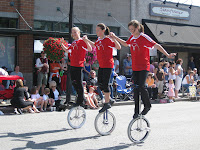 Not quite as attention-getting as “paint the town red,” but still a true statement. Painters from RC Painting began work on the Snoqualmie Depot on September 14 on all the areas below the gutters. While this work was not originally planned for this year, it nicely complements the painting performed above the gutter line last summer, also by RC Painting crews.
Not quite as attention-getting as “paint the town red,” but still a true statement. Painters from RC Painting began work on the Snoqualmie Depot on September 14 on all the areas below the gutters. While this work was not originally planned for this year, it nicely complements the painting performed above the gutter line last summer, also by RC Painting crews.Unfortunately, the 30 June 2009 arson attack blistered paint over a wide area and necessitated at least some painting. A difficulty in matching color combined with the age of the existing paint was making it difficult to complete repairs without it appearing that something wasn’t quite right. So thanks to the financial support of several of the Museum's board members, much of the cost of painting the entire depot has been funded. And now resplendent in fresh green, white and red paint, it looks as crisp as it did in '89!
 RC Painting is based in Woodinville and is owned by Randy Cowan and his son. Randy is a Mt Si High graduate and growing up in Snoqualmie he developed a strong affinity for the Snoqualmie Depot. Paint foreman John is also a Mt. Si graduate and has the distinction of being involved in the depot painting project in 1989, which was completed just in time to celebrate the Washington State centennial.
RC Painting is based in Woodinville and is owned by Randy Cowan and his son. Randy is a Mt Si High graduate and growing up in Snoqualmie he developed a strong affinity for the Snoqualmie Depot. Paint foreman John is also a Mt. Si graduate and has the distinction of being involved in the depot painting project in 1989, which was completed just in time to celebrate the Washington State centennial.The Snoqualmie Depot was built in 1890 for the Seattle, Lake Shore and Eastern Railway. Later part of the Northern Pacific and Burlington Northern, depot ownership was given to the Northwest Railway Museum in 1976. Listed on the National Register of Historic Places and the City of Snoqualmie Landmarks Register, the depot has been restored to its appearance in 1900. It receives over 85,000 visitors per year and is the centerpiece of the Northwest Railway Museum collection, and the City of Snoqualmie's downtown historic district.





